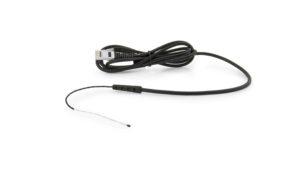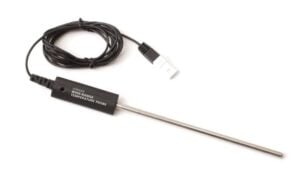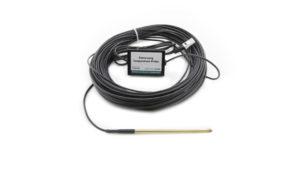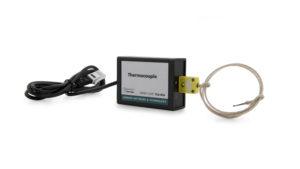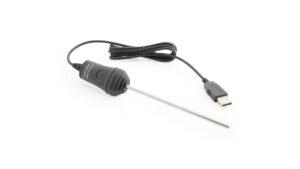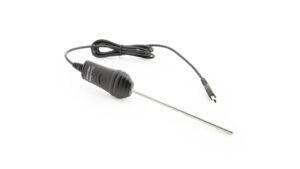The Stainless Steel Temperature Probe is a rugged, general-purpose temperature sensor that can be used in organic liquids, salt solutions, acids, and bases. Use it as you would use a thermometer for experiments in chemistry, physics, biology, Earth science, and environmental science.
Menu
Stainless Steel Temperature Probe
- Products
- Browse
- Sensors
- Temperature Sensors
- Stainless Steel Temperature Probe
Stainless Steel Temperature Probe
Stainless Steel Temperature Probe
$43.00
The Stainless Steel Temperature Probe is a rugged, general-purpose temperature sensor that can be used in organic liquids, salt solutions, acids, and bases. Use it as you would use a thermometer for experiments in chemistry, physics, biology, Earth science, and environmental science.
ORDER CODE:
TMP-BTA
Categories Sensors, Temperature Sensors
Reflectivity of Light (Computer)
Using LabQuest 2 in Lab 12 of Vernier Chemistry for for use with AP Chemistry to measure.
Specifications
- Temperature range: –40 to 135°C (–40 to 275°F)
- Maximum temperature that the sensor can tolerate without damage: 150°C
- Typical Resolution:
- 0.17°C (–40 to 0°C)
- 0.03°C (0 to 40°C)
- 0.1°C (40 to 100°C)
- 0.25°C (100 to 135°C)
- Temperature sensor: 20 kΩ NTC Thermistor
- Accuracy: ±0.2°C at 0°C, ±0.5°C at 100°C
- Response time (time for 90% change in reading):
- 10 seconds (in water, with stirring)
- 400 seconds (in still air)
- 90 seconds (in moving air)
- Probe dimensions:
- Probe length (handle plus body): 15.5 cm
- Stainless steel body: length 10.5 cm, diameter 4.0 mm
- Probe handle: length 5.0 cm, diameter 1.25 cm
Experiments
Elementary School (25 experiments)
Middle School (38 experiments)
High School (109 experiments)
College (71 experiments)
Requirements
Choose a platform below to see its compatibility requirements.
LabQuest
| Interface | LabQuest App |
|---|---|
| LabQuest 3 | Full support |
| LabQuest 2 (discontinued) | Full support |
| LabQuest (discontinued) | Full support |
Computers
| Software | |||
|---|---|---|---|
| Interface | Graphical Analysis | Logger Pro | Logger Lite |
| LabQuest Mini | Full support | Full support | Full support |
| LabQuest 3 | Full support | Full support | Incompatible |
| LabQuest 2 (discontinued) | Full support | Full support | Full support |
| LabQuest Stream (discontinued) | Full support 1 | Full support | Full support 1 |
| Go!Link | Full support | Full support | Full support |
| LabQuest (discontinued) | Full support | Full support | Full support |
| LabPro (discontinued) | Incompatible | Full support | Full support |
Compatibility Notes
- Connect LabQuest Stream via USB. Wireless connection is not supported.
Chromebook
| Software | |
|---|---|
| Interface | Graphical Analysis |
| LabQuest Mini | Full support |
| LabQuest 3 | Full support |
| LabQuest 2 (discontinued) | Full support |
| LabQuest Stream (discontinued) | Full support 1 |
| Go!Link | Full support |
| LabQuest (discontinued) | Full support |
Compatibility Notes
- Connect LabQuest Stream via USB. Wireless connection is not supported.
iOS
| Software | ||
|---|---|---|
| Interface | Graphical Analysis | Graphical Analysis GW |
| LabQuest Stream (discontinued) | Full support | Full support |
| LabQuest 3 | Full support 1 | Full support 1 |
| LabQuest 2 (discontinued) | Full support 1 | Full support 1 |
Compatibility Notes
- iOS and Android™ devices can only connect to LabQuest 2 or LabQuest 3 via Wireless Data Sharing.
Android
| Software | ||
|---|---|---|
| Interface | Graphical Analysis | Graphical Analysis GW |
| LabQuest Stream (discontinued) | Full support | Full support |
| LabQuest 3 | Full support 1 | Full support 1 |
| LabQuest 2 (discontinued) | Full support 1 | Full support 1 |
Compatibility Notes
- iOS and Android™ devices can only connect to LabQuest 2 or LabQuest 3 via Wireless Data Sharing.
Arduino
| Software | |
|---|---|
| Interface | Arduino |
| Vernier Arduino® Interface Shield | Full support |
LabVIEW
| Software | |
|---|---|
| Interface | NI LabVIEW |
| SensorDAQ (discontinued) | Full support |
| Vernier myDAQ Adapter | Full support 1 |
| Go!Link | Full support |
| LabQuest Mini | Full support |
| LabQuest Stream (discontinued) | Full support |
| LabQuest 3 | Full support |
| LabQuest 2 (discontinued) | Full support |
| LabQuest (discontinued) | Full support |
Compatibility Notes
- You can only read the raw count/raw voltage output by this sensor. You must do the programming to convert to proper sensor units.
Texas Instruments
| Software | |||||
|---|---|---|---|---|---|
| Interface | EasyData | DataMate | TI-84 SmartView | DataQuest | TI-Nspire Software |
| EasyLink | Full support 1 | Incompatible | Full support 2 | Full support | Full support 2 |
| CBL 2 (discontinued) | Full support 3 | Full support 3 4 | Incompatible | Incompatible | Incompatible |
| LabPro (discontinued) | Full support 3 | Full support 3 4 | Incompatible | Incompatible | Incompatible |
| TI-Nspire Lab Cradle (discontinued) | Incompatible | Incompatible | Incompatible | Full support | Full support |
Compatibility Notes
- Use with TI-84 Plus calculators only.
- Requires an Easy to Go! adapter
- CBL 2 and LabPro interfaces cannot be used with TI-84 Plus CE calculators.
- DataMate cannot be used with color screen TI-84 Plus calculators; use EasyData with these calculators.
What's Included
Vernier Stainless Steel Temperature Probe
Accessories
Support
Warranty
5-year limited warranty
See our warranty policy
Contact Us
- Recommended: Online Support
- Email: support@vernier.com
- Toll-free: 1-888-837-6437
Related Products
-
Thermocouple
$79.00 -
Go!Temp
Starts at $49.00 -
EasyTemp
$48.00
Educational use only: Vernier products are designed for educational use. They are not appropriate for industrial, medical, or commercial applications.



